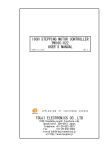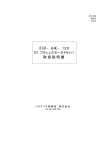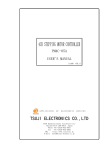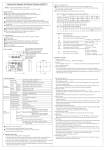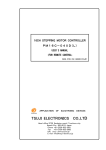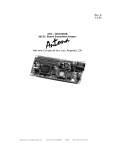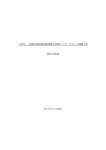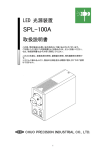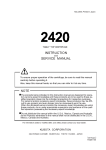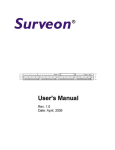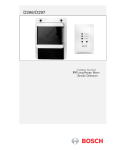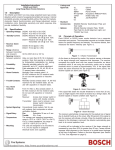Download PM16C-04, -04S Manual
Transcript
16CH STEPPING MOTOR CONTROLLER PM16C−04,04S USER'S MANUAL (2449,2519 APPLICATION OF VER.3) ELECTRONIC DEVICES TSUJI ELECTRONICS CO.,LTD 3739 Kandatsu-machi Tsuchiura-city Ibaraki-Pref 300-0013 Japan Phone +81-(0)29-832-3031 fax +81-(0)29-832-2662 URL http://www.tsujicon.jp E-mail [email protected] COMMAND LIST (GP−IB, RS232C) COMPLETELY COMPATIBLE TO PM16C-02N,-02Z COMMAND EXCEPT "*" MARKED COMMAND MODE R/L R/L R/L R R/L R R/L R COMMAND S1R S1L S10 S11□ S12□ S1301 S1302 S1304 S1308 S130F S1380 S14 S15□ S16□ S20 S20D S21 S22 S22D S23 S24 S24D S25 S26 S26D S27 S30□□ S31□□ S32XXX XXX□□ OR S32XXX XXX□□B S32□ ±DDDDDDD or S32□ ±DDDDDDDB S33XXX XXX□□ OR S33XXX XXX□□B S33□ ±DDDDDDD or S33□ ±DDDDDDDB REPLY ETC. remote mode change local mode change R□□□□ motor channel No. reply of "A, B, C, D" figure * set motor channel □ to A set motor channel □ to B SRQ set when A motor stopped SRQ set when B motor stopped SRQ set when C motor stopped * SRQ set when D motor stopped * SRQ when A,B,C,D motor stopped (combination available) a part * SRQ cancel (also with GP-IB COMMAND "IFC") SRQ flag read R□□ (HEX) set motor channel □ to C * set motor channel □ to D * A position data read reply:R□□□□□□ (HEX) A position data read reply:±DDDDDDD(DEC) * A position status read reply:R□□ (HEX) B position data read reply:R□□□□□□ (HEX) B position data read reply:±DDDDDDD(DEC) * B position status read reply:R□□ (HEX) C position data read reply:R□□□□□□ (HEX) * C position data read reply:±DDDDDDD(DEC) * C position status read reply:R□□ (HEX) * D position data read reply:R□□□□□□ (HEX) * D position data read reply:±DDDDDDD(DEC) * D position status read reply:R□□ (HEX) * A position 2 byte command □□:command 08:+jog, 09:-jog 0C:+CSPD scan 0D:-CSPD scan 0E:+scan 0F:-scan 16:pause on 17:pause off 18:hold off 19:hold on 1E:+scan & HP stop 1F:-scan & HP stop 40:slow stop 80:EM.stop B position 2 byte command □□:command 08:+jog, 09:-jog 0C:+CSPD scan 0D:-CSPD scan 0E:+scan 0F:-scan 16:pause on 17:pause off 18:hold off 19:hold on 1E:+scan & HP stop 1F:-scan & HP stop 40:slow stop 80:EM.stop A position 8 byte command XXXXXX:HEX position data □□:command 10:CSPD REL.IDX 11:CSPD ABS.IDX 12:REL.IDX 13:ABS.IDX auto backlash correction with "B" A position DEC index command * □: A: absolute index scan, R: relative index scan ±DDDDDDD:DEC position data auto backlash correction with "B" B position 8 byte command XXXXXX:HEX position data □□: command 10:CSPD REL.IDX 11:CSPD ABS.IDX 12:REL.IDX 13:ABS.IDX auto backlash correction with "B" B position DEC index command * □: A: absolute index scan, R: relative index scan ±DDDDDDD:DEC position data auto backlash correction with "B" MODE R COMMAND S3□ S38□□ S39□□ R/L S3AXXX XXX□□ OR S3AXXX XXX□□B S3A□ ±DDDDDDD or S3A□ ±DDDDDDDB S3BXXX XXX□□ OR S3BXXX XXX□□B S3B□ ±DDDDDDD or S3B□ ±DDDDDDDB S4XY S4XPS S4XFL S4XBL R S5XY□□ R/L S5XPS ±DDDDDDD S5XFL ±DDDDDDD S5XBL ±DDDDDDD S6 R/L BXhhhh BXH? BX±DDDD BX? PIO? PIO COM RD WXXYY VER? REPLY ETC. speed change S34:L SPEED S35:M SPEED S36:H SPEED C position 2 byte command □□:command 08:+jog, 09:-jog 0C:+CSPD scan 0D:-CSPD scan 0E:+scan 0F:-scan 16:pause on 17:pause off 18:hold off 19:hold on 1E:+scan & HP stop 1F:-scan & HP stop 40:slow stop 80:EM.stop D position 2 byte command □□:command 08:+jog, 09:-jog 0C:+CSPD scan 0D:-CSPD scan 0E:+scan 0F:-scan 16:pause on 17:pause off 18:hold off 19:hold on 1E:+scan & HP stop 1F:-scan & HP stop 40:slow stop 80:EM.stop C position 8 byte command XXXXXX:HEX position data □□: command 10:CSPD REL.IDX 11:CSPD ABS.IDX 12:REL.IDX 13:ABS.IDX auto backlash correction with "B" C position DEC index command * □: A: absolute index scan, R: relative index scan ±DDDDDDD:DEC position data auto backlash correction with "B" D position 8 byte command XXXXXX:HEX position data □□: command 10:CSPD REL.IDX 11:CSPD ABS.IDX 12:REL.IDX 13:ABS.IDX auto backlash correction with "B" D position DEC index command * □: A: absolute index scan, R: relative index scan ±DDDDDDD:DEC position data auto backlash correction with "B" data read command X: channel No.(0-F) Y: data No.(0-F) reply:R□□□□□□ (HEX) 3 byte data from read data address position data read X: channel No.(0-F) PS: position data read * reply:±DDDDDDD (DEC) forward DGLS read X: channel No.(0-F) FL: forward DGLS read * reply:±DDDDDDD (DEC) backward DGLS read X: channel No.(0-F) BL: backward DGLS read * reply:±DDDDDDD (DEC) data write command X: channel No. Y: data No. □□: write data (HEX) position data write X: channel No.(0-F) PS: position data write * ±DDDDDDD : write data (DEC) forward DGLS write X: channel No.(0-F) FL: forward DGLS read * ±DDDDDDD: write data (DEC) backward DGLS write X: channel No.(0-F) BL: backward DGLS read * ±DDDDDDD: write data (DEC) status & LS read (a row of data is B,A,D,C for "-02N" compatible) reply:R□□□□ □:HEX CODE REM/LOC, LIMIT SW * backlash correction data(for CH X) set (h:HEX,D8F1∼270F) * backlash correction data(for CH X) read reply: Rhhhh(HEX) * backlash correction data(for CH X) set 0∼±9999(decimal) backlash correction data(for CH X) read reply: ±DDDD(DEC) PIO port status read * reply:PIO :PIO port COM :PIO communication port set PIO port as a normal PIO port * set PIO port as a PIO communication port * data read from PIO port * reply:RXXYY XX: port 1 data YY: port 0 data(HEX) data write to PIO port XX: port 1 data YY: port 0 data(HEX) * read version information reply: 1.05 00−07−20 Added command MODE R R/L COMMAND FHPA FHPB FHPC FHPD RTHPA RTHPB RTHPC RTHPD DPX DNX GFXDDDD SPHXDDDDD SPMXDDDDD SPLXDDDDD SPCXDDDDD G?X GF?X HP?X SPH?X SPM?X SPL?X March 3, 2001 REPLY ETC. Find Home Position of channel A Find Home Position of channel B Find Home Position of channel C Find Home Position of channel D Return Home Position of channel A Return Home Position of channel B Return Home Position of channel C Return Home Position of channel D change start direction of channel X to positive change start direction of channel X to negative write offset data X: channel D: decimal write HSPD X: channel DDDDD: PPS unit speed data write MSPD X: channel DDDDD: PPS unit speed data write LSPD X: channel DDDDD: PPS unit speed data change speed while scanning X: channel DDDDD: PPS unit speed data read home position status X:0 - F(channel) reply RHH :H ASCII hex read offset data X: channel reply RDDDD :d ASCII dec. read home position X: channel reply ±DDDDDDD ASCII 7 dec. read HSPD of channel X reply RDDDDD D: ASCII 5 dec. read MSPD of channel X reply RDDDDD D: ASCII 5 dec. read LSPD of channel X reply RDDDDD D: ASCII 5 dec. CONTENTS 1.Abstract page 1) Characteristics ・・・・・・・・・・・・・・・・・・・・・・・・・・ 1 2) Concept of PM16C control・・・・・・・・・・・・・・・・・・・・・・ 2 2.Panel layout 1) Front panel layout ・・・・・・・・・・・・・・・・・・・・・・・・ 3 2) Function SW (in detail) ・・・・・・・・・・・・・・・・・・・・・・ 3 3) Rear panel layout ・・・・・・・・・・・・・・・・・・・・・・・・ 4 4) Connectors on the rear panel・・・・・・・・・・・・・・・・・・・・ 4 3.Setting the motor characteristics 1) Power on・・・・・・・・・・・・・・・・・・・・・・・・・・・・・・ 5 2) Set data・・・・・・・・・・・・・・・・・・・・・・・・・・・・・・ 5 3) Prepare the data setting・・・・・・・・・・・・・・・・・・・・・・ 6 4) Procedure of data setting ・・・・・・・・・・・・・・・・・・・・・ 6 A. Digital CW LS ・・・・・・・・・・・・・・・・・・・・・・・・・ 6 B. digital CCW LS ・・・・・・・・・・・・・・・・・・・・・・・・・ 6 C. HSPD (Highest Speed) ・・・・・・・・・・・・・・・・・・・・・ 7 D. MSPD (Mid Speed) ・・・・・・・・・・・・・・・・・・・・・・・ 8 E. LSPD (Low Speed) ・・・・・・・・・・・・・・・・・・・・・・・ 8 F. RATE (speed up/down rate)・・・・・・・・・・・・・・・・・・・ 8 G. LMSW (Limit SW etc.) ・・・・・・・・・・・・・・・・・・・・・ 8 H. Jogging count ・・・・・・・・・・・・・・・・・・・・・・・・・ 9 I. Home position data ・・・・・・・・・・・・・・・・・・・・・・・ 9 5) Finish to set data・・・・・・・・・・・・・・・・・・・・・・・・・10 4.Local mode driving 1) Speed selection ・・・・・・・・・・・・・・・・・・・・・・・・・・10 2) Changing the driving mode ・・・・・・・・・・・・・・・・・・・・・10 HP stop mode REL and ABS indexed SCAN Continuous SCAN 3) Channel selection ・・・・・・・・・・・・・・・・・・・・・・・・・12 4) Jog driving ・・・・・・・・・・・・・・・・・・・・・・・・・・・・12 5) Position data preset・・・・・・・・・・・・・・・・・・・・・・・・12 6) Synchronous driving ・・・・・・・・・・・・・・・・・・・・・・・・13 7) Auto hold-off ・・・・・・・・・・・・・・・・・・・・・・・・・・14 8) Inhibiting Jog・・・・・・・・・・・・・・・・・・・・・・・・・・・14 9) Hand box operation ・・・・・・・・・・・・・・・・・・・・・・・・14 5.Remote mode driving 1) External communication over PIO port(omitted) ・・・・・・・・・・・14 2) RS232C, GP-IB data communication・・・・・・・・・・・・・・・・・・14 2-1) Command in detail・・・・・・・・・・・・・・・・・・・・・・・・16 a) Channel select, channel read and remote/local・・・・・・・・16 change command S1□□ ・・・・・・・・・・16 b) Data & status read command S2□ ・・・・・・・・・・16 c) Motor control command S3□□□ ・・・・・・・・・・17 d) Data read out command S4□□ ・・・・・・・・・・21 2-2) Procedure of data communication over GP-IB, RS232C or LAN communication ports・・・・・・・・・・・・・・・・・・・・・・24 2-3) Sample program of data communication ・・・・・・・・・・・・・・24 6.Auto backlash elimination 1) What is the auto backlash elimination ・・・・・・・・・・・・・・24 2) Command reference ・・・・・・・・・・・・・・・・・・・・・・・・・24 3) When you use backlash elimination ・・・・・・・・・・・・・・・・・25 7.Home position detection in remote mode (omitted) ・・・・・・・・・・・・・25 8.16 bit digital data IN/OUT (omitted) ・・・・・・・・・・・・・・・・・・・25 9.Version information ・・・・・・・・・・・・・・・・・・・・・・・・・・・25 10. Another added command (omitted)・・・・・・・・・・・・・・・・・・・・・・25 11. Additional function Pulse output style change ・・・・・・・・・・・・・・・・・・・・・・26 12. Connection with outer equipment・・・・・・・・・・・・・・・・・・・・・・27 13. Specification ・・・・・・・・・・・・・・・・・・・・・・・・・・・・・・28 PM16C-04, PM16C-04S User's Manual 1.Abstract PM16C-04,PM16C-04S, designed as an upper version of PM16C-02Z (or PM16C-02N), has same communication command and similar operation as PM16C-02Z (or PM16C-02N). PM16C-04, PM16C-04S can control 4 motors at a time, although PM16C-02Z (or PM16C-02N) can control 2 motors at a time.PM16C-04 has a 10BASE-T Ethernet interface for LAN use. PM16C-04S is a low cost type without LAN inter face. 1) Characteristics ① One PM16C can control less than 16 stepping motors. * Characteristics(HSPD,MSPD,LSPD,RATE,LMSW)of each motors can be set as you like. * Any channel can be inhibited to operate. ② Four motors can be driven synchronously. * The four motors can be started at the same time. * Limit SW status, Pulse out status and Position of the four motors are shown on the front panel. ③ Driving Mode REMT LOCL SET UP HP ABS DRIVING REL (all LEDs are turned of f) REMT :Controlled by other equipment over communication line LOCL :Controlled by Switches on the front panel SET UP :Setting of the motor driving procedure DRIVING :Motor driving is possible in this mode(set up lump turn off) SCAN :Simple driving(can be stopped only by Limit SW or Stop SW on front panel) ABS :Absolute Position Set Driving REL :Relative Position Set Driving HP :Home Position Stop Driving * Present driving mode is shown on the front panel by LED * Modes, and position are memorized as back up data by battery for five years. * The data can be set in REMT mode, as above shown. * Use the data communication forms as below. 1 PIO 2 GP-IB 3 RS232C 4 Handy console (PM16-HD1:option) 5 Ethernet (LAN) ④ Motor is stopped, when a. Limit Switch is detected. b. Home Position Switch is detected. c. Software Limit Switch is detected. d. stop switch is pushed. - 1 - SCAN * Enable/disable can be set for each motor. (a,b,c) * Contact type can be set for each motor. (a,b,c) * (d) function is enable in both remote/local. * (c) is a function in which the motor is stopped at the point set by front panel or by remote operation. * In the case of a∼d, the motor is stopped through slow stopping process to prevent detuning. ⑤ Hand box operation * Only 4 channel can be operated, which are displayed on the front panel. * CW/CCW jog operation is possible. * By use of the Hand box, you can operate PM16C, while you watch the machine moving. If you need more multi-function, handy console :PM16-HD1 is useful. Please contact us, and order please. ⑥ Hold off :When motor is stopped, power is automatically turned off. * Each channel can be set to take the hold-off function, or not. * The hold-off can be set externally by command through communication line. ⑦Jog switch is used for: a. Any numbers of steps (1∼9999) driving. b. Inching driving; Only when you keep to push the jog SW, Jogging continues. 2) Concept of PM16C control Stepping motor controller ;PM16C-04(-04S) has ① a CPU which controls the hole of the system, ② four CPU which control the stepping motors. The connections between the four CPU and 16 of stepping motors are changed properly. Present positions, p resent velocities, differential velocities in starting and stopping phase, etc. ar e stored in the memories as battery back up, which are read out and renewed any ti me you need. Push-Button SW LED Lamp IN/OUT port total control CPU communication port PIO GP-IB RS232C display memory *1 LAN *1) LAN is for only PM16C-04 CPU for A ch pulse out connectors display for 16 of Motors CPU for B ch display CPU for C ch display C H A N G E R ・ ・ ・ ・ ・ ・ ・ ・ ・ C H N G ・ ・ CPU for D ch - 2 - input connectors for Limit SW 2.Panel layout 1) Front panel layout Fig.1 Front panel layout 2) Function SW (in detail) REMT : External control mode REMT LOCL LOCL : Manual driving mode. (operated by panel SW) If you keep the SW to be pushed, and turn the power on, MODE MODE then Motor Speed is set to be default data. Default:HSPD=3700PPS,MSPD=650PPS,LSPD=10PPS, RATE=300mS/1000PPS,hold off mode, LS/N.O jog pulse counts=1,CWLS=+1000000,CCWLS=-1000000 * Each pushing changes the remote/local alternately. It can be also operated externally. SET UP SET UP : If you push this SW when motor remains stationary in LOCL, then the mode is changed into set up mode. Please set the data for motor driving in this mode. MODE A PRESET INC B C D By these SWs you can select which motor is driven. Available only in local mode. Each pushing changes lamp on/off alternately. Lamp on CH can be driven at the same time. In SET UP mode you can choose display window. PRESET : a. In DRIVING mode: data of digital SWs are set as present data. By A/B/C/D SW, you can select the CH to which data are preset. b. In set up mode: The values of data are increased. (Large value data such as the Soft ware LS is set by digital SW.) - 3 - START ; a. In DRIVING mode: Function is changed in accordance with mode display lamp mode lmp mode movement when START sw is on all off scan prepare scan. waiting to set direction *1 ABS on ABS scan start to ABS. pos. set by digital SW. REL on REL scan start to REL counts set by digit. SW. HP on HP home position moving *1,*2 *1 In scan and HP, scanning is prepared by pushing this SW. However, the scanning can not start without setting CW/CCW decision by jog SW. *2 see page 9 about details for HP mode. b. In set up mode: Showing data are changed by this SW. Right after entering into set up mode, CW LS data is shown. And, CCW LS,HSPD,MSPD,RATE,LS status・・・ are shown next to next. START DATA STOP STOP ; a. In DRIVING mode: Motor is stopped in both REMT and LOCL modes. b. In set up mode: The value of the data are decreased. (Large value data such as the Soft ware LS is set by digital SW.) DEC caution * mode change SW : ABS→REL→HP→SCAN are circular changed. * speed change SW : L→M→H are circular changed. Changes unit (code / pps) in setup mode. 3) Rear panel layout Fig.2 Rear panel layout *1) LAN connector and LAN MODE set SW are only for PM16C-04 (not PM16C-04S) 4) Connectors on the rear panel 1. PULSE (DE9S) Stepping pulse out for Motor Drivers. 2. LS IN (DE9P) Limit sw signal input for limit sw or photo sensor. 3. PIO (57-40500) PIO communication. - 4 - Available for parallel In/Out port over GP-IB,RS232C communication. 4. GP-IB GP-IB communication. 5. RS232C (DB25S) RS232C communication. 6. DIP SW Status setting for GP-IB,RS232C communication. 7. LAN MODE (only for PM16C-04) Setting for Ethernet (LAN) mode. 8. LAN (only for PM16C-04) 10base-T connector for Ethernet. 9. F3A Fuse holder for power supply. use 3A fuse. 10. AC100V AC power supply. AC85V ∼ AC264V 47∼440Hz 50VA 3.Setting the motor characteristics In PM16C-04,-04S, each data of 16 stepping motors can be set and stored, which is kept as battery back up. The data are kept to be memorized until reset. Then, accurate control is realized for any system. In setting mode, pulse out is stopped. Data can not be set during motor moving. 1) Power on When Power SW is turned on, status become to be default mode within 1 second. operation mode default memorized driving mode driving position REL memorized speed setting MID Other data are set as the value which are the one last time turned off the power, because the all of these data are kept by battery back up. 2) Set data All channel data can be set individually. set No. data meaning 7 CW soft ware LS stop when pulse count > data 8 CCWsoft ware LS stop when pulse count < data 9 HSPD A MSPD b LSPD C RATE speed up/down rate (see table 2 on page 11) d Limit SW status limit sw (N.O, N.C), moving EN/DA, hold off, etc. E JOG step pulse JOG step pulse in local mode b0:start dir. b1:sens.dir. b2:get F data for home position moving high speed data (code) unit select: high speed data (pps unit) speed mid speed data (code) select PB mid speed data (pps unit) value in pps: low speed data (code) set by low speed data (pps unit) Digital SW display: offset pulse (near hp) mode change memorized home position PB - 5 - 3) Prepare the data setting In LOCL mode, set up mode is selected by set up SW. Then, A position display shows the data. By B,C,D select sw, you can change data display window. If the channel No. (which you want to set the data) appears one of 4 display windows, select that window and set the data. If it doesn't, you can select the channel by using INC/DEC SW under channel No. display window. Caution)The display shows the number as HEX (0∼F), then 6and b might be complex. Please take care this point. Display 9 in detail 0 set No. 0 0 CH 0 0000 F F 5 set. data set ch The channel you want to set data is shown in A(B,C,D) position display. The channel can be changed by INC/DEC SW under the display. 4) Procedure of data setting A. Digital CW LS setting No. 7 * Right after entering the set up mode a) Push the data SW (START SW), and select the setting No.7. (7 is not shown, but it is after F.) b) Set data by use of digital SW under the display window. Write the data into the memory by INC SW (PRESET SW) or DEC SW (STOP SW). The data's mean the absolute position where you want to stop the motor during CW driving. c) Channel can be changed by the SW under the display. Display ± 1 CH 2 3 4 5 6 7 data 5 channel B. digital CCW LS setting No.8 a) Push the data SW (START SW), and select the setting No.8. (8 is not shown, but it is after 7.) b) Set data by use of digital SW under the display window. Write the data into the memory by INC SW (PRESET SW) or DEC SW (STOP SW). The data mean the absolute position where you want to stop the motor during CCW driving. c) Channel can be changed by the SW under the display. Display ± 1 CH 2 3 data 4 5 6 7 5 channel - 6 - C. HSPD (Highest Speed) Setting No.9 Can choose code/pps unit by speed change PB. Once chosen it remains in MSPD, LSPD setting. (also after power on/off). Even if you choose the code data, the pps unit data is set to new data automatically. But if you choose the pps data, the code data is not changed to new data. (Setting code data) a) Push the data SW (START SW), and select setting No.9. b) Set data by use of INC SW (PRESET SW) or DEC SW (STOP SW). A relationship between data and speed can be known by use of table 1. 5pps to 40,000pps data are available. c) Channel can be changed by the SW under the display. Display 9 CH 0 set No. 0 0 0 000 F F data 5 channel (Setting PPS unit data) PPS: pulse per second (P/S) a) Push the data SW (START SW), and select setting No.9. b) Set data by use of digital SW under the display window. Write the data into the memory by INC SW (PRESET SW) or DEC SW (STOP SW). 1pps to 100,000pps can be set. c) Channel can be changed by the SW under the display. Display 9 CH 1 0 set No. 0 0 0 0 data 5 channel D. MSPD (Mid Speed) Setting No. A a) Push the data SW (START SW), and select setting No.A. How to set the data is the same as the HSPD. E. LSPD (Low Speed) Setting No. B a) Push the data SW (START SW), and select setting No.b. How to set the data is the same as the HSPD. F. RATE (speed up/down rate) Setting No. C a) Push the data SW (START SW), and select setting No.C. b) Set the data by INC SW (PRESET SW) and DEC SW (STOP SW). A relationship between data and rate can be known by use of table 2. c) Channel can be changed by the SW under the display. Display C CH 0 set No. 0 000 0 0 0 F data 5 channel - 7 - G. LMSW (Limit SW etc.) Setting No. D a) Push the data SW (AB SW), and select setting No.D. b) Set data by use of INC SW (PRESET SW) or DEC SW (STOP SW). c) LS status can be set, while you see the LED to know the present status. (turned on: LS on, turned off: LS off) (details are shown in "LS data structure") d) If highest bit is set to zero (<7FH), which means motor off, then CW and CCW LS lamps are switched to show that the motor can not be driven. e) Channel can be changed by the SW under the display. Display d CH 0 set No. 0 0 000 0 0 1/0 1/0 5 data * LS data structure Higher bit of Hex 1/0 F channel Lower bit of Hex 1/0 1/0 1/0 1/0 1/0 ① CW LS contact (1:B,0:A) ② CCW LS contact (1:B,0:A) ③ ZERO LS contact (1:B,0:A) ④ CW LS (1:enable,0:disable) ⑤ CCW LS (1:enable,0:disable) ⑥ DIGITAL LS (1:enable,0:disable) ⑦ hold off (1:normal,0:hold off) ⑧ motor enable (1:motor on,0:motor off) ①,② CW/CCW LS A/B contact type setting When these bits are 1, they are B contacts. when they are 0, A contacts. A contacts : when LS is struck, the contact becomes electrically to be CLOSE. It is normally open. (so it is also called as N.O contact) Drawing: . B contacts : When LS is struck, the contact becomes electrically to be open. It is normally CLOSE. (so it is also called as N.C contact) Drawing: ③∼⑤ ZERO, CW and CCW LS enable Each LS can be set to be enable or disable. When this bit is 1, the LS is enable. When this bit is 0, the LS is disable. Please care that motor can not stop when LS is kept to be disable. ⑥ Digital LS enable digital LS can be also set to be disable or enable. When this bit is 1, it is enable. When this bit is 0, it is disable. If digital LS is enable, motor can stop at the absolute position where is internally set by digital SW (CW/CCW) as same as hardware LS. ⑦ hold off IF some torque is required to keep the motor remaining stationary, power should be kept to be turned on. But, if there is not such a requirement, some motor drivers can be hold off to prevent the heating up and to save the power. When you use these types of drivers, motor can be more effectively driven by - 8 - this bit operation. When this bit is 1, hold off signal is disable so that power is kept to be turned on all time. When this bit is 0 in manual mode, the power is turned on 0.1s before jog starting, and turned off 0.1S after jog finishing. * The motor, whose power is required to be hold off in remote mode, should be controlled by the sequence, in which the "hold off" is set to be disable before jog starting, and reset to be enable after jog finishing. ⑧Motor enable You can set some motors impossible to drive by use of this bit setting. When this bit is 1, it is normal driving mode that motor can be driven as you like. When this bit is 0, motor can not be driven by any manual SW operation. * If you set the motor impossible to drive by this way, the motor becomes that can not be driven by any remote operation. H. Jogging count Setting No. E a) Push the data SW (START SW), and select setting No.E. b) Set data by use of INC SW (PRESET SW) or DEC SW (STOP SW). The possible dates' range is 1∼9999. c) You can change the channel by the SW under the display. Display E CH 0 set No. 0 9 00 9 9 9 5 data channel I. Home position data Setting No. F a) Push the data SW (START SW), and select setting No.F. There are three data. Just after selecting No.F, home position status of the channel are displayed. By the mode change PB, you can change the contents of the display. (contents: home position status, offset pulse, home position value) (Home position status) Only the start direction of auto home If it is changed, home position found a) Change data by use of INC SW (PRESET b) You can change the channel by the SW position searching is changeable. flag will be cleared. SW) or DEC SW (STOP SW). under the display. Display F set No. CH 0 0 000 0 1 1 1 5 channel direction of auto HP searching (CW:1, CCW:0) memory of HP found direction (CW:1, CCW:0) HP found memory (found:1, not found:0) - 9 - (Home position offset pulse) Can change home position offset pulse data. b) Set data by use of digital SW under the display window. Write the data into the memory by INC SW (PRESET SW) or DEC SW (STOP SW). Data 0∼9999 can be set. c) Channel can be changed by the SW under the display. Display CH F 0 set No. 0 00 9 9 9 9 offset pulse 5 channel (Home position value) Read only data. a) You can change the channel by the SW under the display. Display CH ± 5) 1 2 3 4 5 6 7 5 home position value channel Finish to set data Turn off the set up SW, and get back to driving mode. 4.LOCAL mode driving Only when remote/local SW is set to be local, the motor can be driven in local mode. If this SW is remote, you need to push the SW once, and reenter into local mode. 1) Speed selection By use of speed selecting PB, any speed can be selected from the three speed that are preset in each channel, which are HSPD, MSPD and LSPD. Starting speed of acceleration and final speed of deceleration is LSPD. 2) Changing the driving mode By use of driving mode selecting PB, you can select the mode as you like: HP,REL,ABS and scan(scan mode is the case that all LED which show driving mode are turned off). Just after power on, REL mode is selected. a. HP stop mode (HP mode lamp is flickering) In this mode motor will stop when HP sensor on. When sensor is on the moving direction and the value of home position are memorized. It is necessary that the scan speed is slower than the sensor reply speed. You can choose the way to find home position as follows. Status not found yet (select ch. lamp is flickering) found already (select ch. lamp is on) method procedure accur time expl manual ch. select→JOG or START+JOG △ short ① semi auto ch. select→START PB > 1Sec. ◎ long ② semi auto ch. select→START PB ◎ short ③ - 10 - Find home position. ① Manual detection. 1.Choose the channel which you wont to find home position. In the HP STOP mode, can see if the channel already has home position by the selected channel lamp. flickering : not found yet. lamp on : already found. lamp off : not selected as a moving channel. 2.Move to the one side near home position from which you want to approach. If you pass the home position in this process you must pass without HP STOP mode. You can't pass through the home position in the HP STOP mode. 3.Next move toward the home position in HP STOP mode (in slow speed if possible). 2 ways are available. One is by using only JOG sw and the other is start PB + JOG sw. Start ready status, which is prepared by start PB, can be cleared by STOP sw. 4.Detecting the up edge of home position sensor, motor will stop quickly and home position detecting procedure will finish. After the finishing of home position detection the selected channel lamp status will change from flickering to continuous lamp on. Direction from which it approached and the value of home position are memorized. The data about home position detection are stored as battery back up. If the detection is done in high speed moving, notice the influence to the mechanic or detuning. If overrun through the sensor occurred when stopped, the detection is failed. You should try the process once more. ② Semi auto detection when no HP memory. In this method the detection is done automatically by using CW, CCW limit sw. So the limit sw must work securely. 1.Select and move enable the channel you want to find home position. In HP STOP mode selected channel lamp that has no home position memory will flicker. 2.Press the START PB and the lamp will turn on. (If you decide the moving direction with JOG SW, the method of home position detection is as the same above ①) 3.Pressing the PB more than 1 second, the motor will start to move toward some direction. Some direction means CCW direction as a default direction. Can change the default direction as you want. (The start direction is opposite one that is the approaching side of home position.) If changed, CW, CCW should be CCW, CW below. 4.When CCW limit sw is turned on, the motor will slow down and stop, then return to the CW direction. If home position sensor turned on before CCW limit sw, go to 6th sentence. 5.When HP sensor turns on, the motor will slow down and stop, then return to the CCW direction. 6.When HP sensor turns off (or turns on then turns off), the motor will slow down and stop, then return to the CW direction and when HP sensor turns on, the motor will stop and finish the HP detection. After HP detection flickering selected channel lamp will change to continuous turn on status. And also home position informations are memorized. 7.If CW limit sw turns on instead of HP sensor turns on, the detection process will be failed and finish. - 11 - It can also be forced to stop by stop PB. ③ Semi auto HP detection with HP memory 1.In HP STOP mode, selected channel lamp is continuously lighting when it has HP memory. 2.By pressing START PB, the motor starts to move automatically to the place that is home position plus (or minus) offset pulse. Plus or minus is determined by the direction when last HP detection finished. Offset pulse can be set in advance between 0 to 9999. The offset pulse can be set for each motor as the home position offset data. The default value of offset pulse is 100. 3.Next it move to HP slowly, when HP sensor turns on it stops. The home position informations are re-memorized, so ③ process is reliable after ① process. In this process if the HP sensor doesn't turn on, while moving to HP even if it pass through out of HP +/- offset pulse, the HP detection process will be failed. The HP memory will be cleared and selected channel lamp will be changed to flickering status. If CW or CCW limit sw works, or STOP PB is pressed, HP detection process will also be stopped. But in this case the HP memory will be conserved. b. REL and ABS indexed SCAN In REL mode when START PB pressed the motor steps relatively by the digital sw data. In ABS mode it steps to the absolute data that the digital sw indicate. Can stop by limit switches or STOP PB. c. Continuous SCAN(all mode LED lamps are off) By pressing START PB, START PB lamp will turn on that indicate start ready status. Next by JOG SW, decide the direction, the motor will scan. It can be stopped by STOP PB or limit switches. The start ready status can be cleared by STOP PB. 3) Channel selection While pulse is not being sent, the channel you like to control can be changed by CH select SW in local mode. In the display, the position of the last selected motor is shown. If the SW is operated during pulse-sending, the operation will be ignored. Four display (A,B,C,D) can not control same channel at the same time. The system are programmed that same CH can not be selected at the same time. 4) Jog driving In the direction which is set by jog SW, pulses are sent and motor is driven. If you keep the SW to be pushed more than 0.5 seconds, continuous scan is started. 5) Position data preset Index data can be shown and set in the display by use of PR PB and A,B,C,D PB. - 12 - Table 1 speed data No. 0 1 2 3 4 5 6 7 8 9 A B C D E F 10 11 12 13 14 15 16 17 18 19 1A 1B 1C 1D 1E 1F 20 21 22 23 24 25 26 27 28 29 2A 2B 2C 2D 2E 2F PPS 5 10 25 50 75 100 150 200 250 300 350 400 450 500 550 600 650 700 750 800 900 1,000 1,100 1,200 1,300 1,400 1,500 1,600 1,700 1,800 1,900 2,000 2,100 2,200 2,300 2,400 2,500 2,600 2,700 2,800 2,900 3,000 3,100 3,200 3,300 3,400 3,500 3,600 No. 30 31 32 33 34 35 36 37 38 39 3A 3B 3C 3D 3E 3F 40 41 42 43 44 45 46 47 48 49 4A 4B 4C 4D 4E 4F 50 51 52 53 54 55 56 57 58 59 5A 5B 5C 5D 5E 5F PPS 3,700 3,800 3,900 4,000 4,100 4,200 4,300 4,400 4,500 4,600 4,700 4,800 4,900 5,000 5,100 5,200 5,300 5,400 5,500 5,600 5,700 5,800 5,900 6,000 6,100 6,200 6,300 6,400 6,500 6,600 6,700 6,800 6,900 7,000 7,100 7,200 7,300 7,400 7,500 7,600 7,700 7,800 7,900 8,000 8,200 8,400 8,600 8,800 No. 60 61 62 63 64 65 66 67 68 69 6A 6B 6C 6D 6E 6F 70 71 72 73 74 75 76 77 78 79 7A 7B 7C 7D 7E 7F 80 81 82 83 84 85 86 87 88 89 8A 8B 8C 8D 8E 8F Table 2 rate data PPS 9,000 9,200 9,400 9,600 9,800 10,000 10,200 10,400 10,600 10,800 11,010 11,210 11,410 11,600 11,800 11,990 12,200 12,400 12,600 12,790 12,990 13,200 13,400 13,620 13,810 14,000 14,200 14,400 14,620 14,830 15,010 15,200 15,390 15,580 15,770 15,970 16,180 16,400 16,610 16,830 17,060 17,240 17,420 17,600 17,800 17,990 18,180 18,380 No. 90 91 92 93 94 95 96 97 98 99 9A 9B 9C 9D 9E 9F A0 A1 A2 A3 A4 A5 A6 A7 A8 A9 AA AB AC AD AE AF B0 B1 B2 B3 B4 B5 B6 B7 B8 B9 BA BB PPS 18,660 18,940 19,230 19,530 19,840 20,160 20,500 20,830 21,190 21,550 21,930 22,320 22,730 23,150 23,590 24,040 24,510 25,000 25,510 26,040 26,600 27,170 27,620 28,090 28,570 29,070 29,590 30,120 30,680 31,250 31,850 32,470 33,110 33,780 34,480 35,210 35,970 36,500 37,040 37,600 38,170 38,760 39,370 40,000 No. 0 1 2 3 4 5 6 7 8 9 A B C D E F 10 11 12 13 14 15 mS/1000PPS 1,000.0 800.0 600.0 500.0 400.0 300.0 200.0 150.0 125.0 100.0 75.0 50.0 30.0 20.0 15.0 10.0 7.5 5.0 4.0 2.0 1.5 1.0 Can be set in this range HSPD=0∼BB MSPD=0∼BB LSPD=0∼A1 RATE=0∼12 6) Synchronous driving A,B,C,D can be driven individually. When more than 2 motors are selected, they can be started synchronously at the same time by JOG, START switches. - 13 - 7) Auto hold-off If you set the motor hold off, the power of the motor is turned on only when the motor is being driven in local mode. 8) Inhibiting Jog If you set the motor off, any operations shown above can't drive motors. (refer page 7 3-4)-G. LMSW ) 9) Hand box operation By use of hand box, you can drive motors while you watch the mechanical moving. Then, four CH displayed front panel can be operated as CW/CCW jog driving. You can change control CH on the front panel. In the HP mode, you can also operate by the hand box. 5.Remote mode driving This mode is possible when remote/local SW shows to be REMT. If the remote/local SW shows LOCL, push the SW again or send the command externally to change the mode to be REMT. And, after that, continue to operate as below. Remote mode driving can be operated by; 1 Parallel I/O 2 GP-IB 3 RS232C Above 3 are common in PM16C-04 and PM16C-04S. About the communication over Ethernet (LAN:10base-T, only for PM16C-04), see a separate volume. These communication mode can be selected by setting SW of rear panel. (as shown below) The setting SW should be changed before power turned on if necessary. 1) External Communication over PIO port (omitted) Fig.3 external communication sw 1 2 3 4 5 6 7 8 ON ↑ ↓ OFF 1:ON→RS232C port enable 2:ON→GP-IB port enable(*1) 3: 4: 5: GP-IB my address or 6: RS232C baud rate 7: setting 8: ↑ ↑ ↑ ↑ ↑ ↑ ↑ ↑ ↑ ↑ When GP-IB is selected → 24 23 22 21 20 (my address) ↑ ↑ ↑ ↑ ↑ When RS232C is selected →(N.C)A B C D→→→→ A:9600 B:4800 C:2400 D:1200 * When both RS232C and GP-IB are ordered at the same time, is selected. baud If more than baud two SWs are baud on, higher baud is selected. only RS232C *1) By use of the optional handy console (PM16-HD1) connected to RS232C port in GP-IB mode, less than additional 6 motors can be controlled (position monitoring, jog, scan, REL. IDX, ABS IDX and preset) during GP-IB control. 2) RS232C,GP-IB data communication a) Introduction - 14 - A PM16C-04 (or -04S) has a GP-IB control IC;TMS9914A. and has a RS232C control IC;HD64941. In this system, nonsense command or impossible command(EX. reverse drive during normal drive)are ignored so that almost all time you can access from these communication lines (protect from hung up). Receive form should be S□・・・・□CR+LF*. □:ASCII * de-limitter is fixed to CR+LF. When CR(0DH)+LF(0AH)is detected during receiving, the command is rapidly analyzed and done by PM16C-04 (or -04S). However, if it can't be analyzed, no operation is done. When PM16C receives information that some data should be returned back, the data are rapidly prepared and sent back. These operations are done for about less than 1mS. Drive command form is;R□・・・・□CR+LF. Remote controls such as receiving, analyzing and doing from RS232C/GPIB line are operated by interrupting in PM16C-04 (or -04S). Therefore, these operations need not have waiting time. Then, three types of commands are possible. TYPE 1:rapid done・・・data reading/motor stop TYPE 2:waiting for some status done・・・CH select TYPE 3:some status requiring done・・・motor control In the case of that the data are read out after sending the command of TYPE 2/3, it is important as above shown. b) Baud rate /address set SW:as above mentioned c) character structure 1.RS232C data are 1 START bit +8 bit data +1stop bit no parity (fixed) 2.De-limitter is fixed to be CR+LF. 3.Send/receive command code is ASCII. d) In RS232C communication, software hand shake (XON,XOFF)is not supported. e) Connection between PM16C and other controller (in the case of RS232C. GP-IB is omitted here.) 1.PANEL:DB25S CABLE:DB25P 2.PIN ASSIGN (→shows the flow of data) PM16C-04, -04S other controller 1 SHIELD can be omitted 1 SHIELD 2 TXD 3 RXD 3 RXD 2 TXD 5 CTS 4 RTS 7 SIG.GND 7 SIG.GND 6 DSR 8 DCD 20 DTR RS23C2C debug tool If RS232C line can not work well, the cause of that is hard to be found. Therefore, we prepared the tool for helping to solve these problems. Please keep the stop PB on while power is turned on, then received character is displayed echo back. You can refer the character and get some information about the problem you meet. If echo back is not well displayed, the RS232C line is possible to be badly wired. Or, if you get curious characters, baud rate and parity should be examined. - 15 - 2-1) Command in detail(for both RS232C and GP-IB) a) Channel select, channel read and remote/local change command If these commands are received during pulse sending, any operations are not started before finishing the pulse out. It is enable only in REMT mode. CH reading out and REM/LOCL changing can be operated both in remote/local. Data are read out as the receive form below. command form S 1 □ □ channel data(0∼F) (In Ch reading and remote/local changing, it can be ignored.) R:Remote mode change (TYPE 3) L:LOCL mode change (TYPE 3) 0: position channel read (TYPE 1) 1:A position channel select(TYPE 2) 2:B position channel select(TYPE 2) 3:SRQ (next 2characters are 8 bit pattern ) 4:SRQ status read out (automatically cleared after SRQ status reading out) B0:A pos.stop SRQ B7 B0 B1:B pos.stop SRQ B7:ignore SRQ(reset) 5:C position channel select(TYPE 2) 6:D position channel select(TYPE 2) command EX) S1301 : S1302 : S138F : S1380 : Receive form for "S10" R □ □ □ □ A pos.stop SRQ B pos.stop SRQ One of A,B,C,D stop then SRQ SRQ reset,SRQ clear command channel of A, B, C, D position (0-F) Receive form for "S14" command R □ □ SRQ request status lower bites "0" * When ch is selected, old data are saved and new data are set. These process takes a few times.(about 30mS) Therefore, you should send the command after completing the ch selection . The completing can be known by Ch reading out command. b) Data & status read command At any time, position data and status are usually read out by this command. This is enable in whichever modes remote/local. command form S 2 □ 0:A position data read (TYPE 1) 1:A position status read( 〃 ) 2:B position data read ( 〃 ) - 16 - 3:B position status read( 〃 ) 4:C position data read ( 〃 ) 5:C position status read( 〃 ) 6:D position data read ( 〃 ) 7:D position status read( 〃 ) * Can get decimal data by adding "D" to the command when you send the position read out command. ex) S20D Receive form D7 R □ □ □ □ □ □ R □ □ Status REG. D6 D5 D4 D3 D2 D1 D0 position data HEX CODE Status data(2 HEX CODE (2's compliment of 6 hex code) ASCII hex code) ASCII *) Firmware version "V1.30" BUSY etc. can be read out by DRIVE "VER?" command. DREND(V1.30∼) COMERR(V1.30∼) COMERR(∼V1.29, "0":V1.30∼) LDEND SSEND ESEND BUSY: shows Pulse controller is being operated now. During the moving, speed change and pulse out command are ignored, though slow stop and EM stop command are effective. BUSY status of OD17 shows CPU status which controls hole of the system. On the other hand, the BUSY here shows four CPU's status (A,B,C,D) which control A, B, C, D motors. DRIVE :Pulse out is being continued. COMERR :The command is nonsense. DREND :Pulse out drive finished. LDEND :Pulse out is stopped by CWLS and CCWLS. SSEND :Pulse out is slowly stopped by slow stop command. ESEND :Pulse out is rapidly stopped by EM stop command. caution)COMERR,LSEND,SSEND and ESEND are enable, only if BUSY=0. These bits are cleared by rewriting the next command. LSEND,SSEND and ESEND bit are nonsense, when pulse are not sent out by the command. c) Motor control command Data and command are written for A, B, C, D position control 2 bytes command form S 3 □ □ □ 2 byte command 0:A position 2 byte command(TYPE 1:B position 2 byte command(TYPE 4:LSPD set(TYPE 3) 5:MSPD set(TYPE 3) 6:HSPD set(TYPE 3) 8:C position 2 byte command(TYPE 9:D position 2 byte command(TYPE *slow stop and EM.stop command are TYPE 1. - 17 - 3)* 3)* 3)* 3)* ① +,- jog command command 08 :+(CW) jog drive 09 :-(CCW) jog drive command for jog drive ② +,- constant speed scan command By this command, motor speed is set to be constant value which is preset (*) as you like. command 0C :+(CW) constant scan drive 0D :-(CCW) constant scan drive * The speed is set at the value which is last selected by push SW (H,M and L) in LOCL mode, or which is last selected by speed select command ⑧ in REMT mode. This procedure is same in other controls shown below. ③ +,- scan command Motor speed is increased from LSPD to set value as trapezoidal driving. command 0E :+(CW) scan drive 0F :-(CCW) scan drive ④ ⑤ speed selection command By this command, the motor speed is selected from HSPD,MSPD or LSPD. All A, B, C, D POS are set as same range. This command is effective for the channel whose motor remains stationary. The channel of the moving motor is kept to the old range. command EX) S34 : LSPD select S35 : MSPD select S36 : HSPD select Commands for synchronous starting of more than one motor The pause command should be sent to PM16C before starting of more than one motor at the same time.(*) If jog command is sent after pause command, motors can not be driven until pause off command. command 16 : pause 17 : pause off EX) S3X16 : pause S3X17 : pause off * The sequence of Synchronous start is that; 16H(pause) is given to the each controller, and after that, 17H(pause off) is given to start more than one motor synchronously. The third character(X) shows channel, and then 0, 1, 8 and 9 are effective for all A, B, C, D. These commands don't give any effects to the motors that are already moving. - 18 - ⑥ hold off set/rest command command 18 : hold off set 19 : hold off reset EX) S3018 : A pos.hold off set S3019 : A pos.hold off reset S3118 : B pos.hold off set * When you need to start the motor from the state of hold you should cancel the hold off state enough time before the control pulse in accordance with motor's character. Of course, when you set hold off again, you should send command enough time after finishing to send the control ⑦ scan & HP stop command By this command, scan and home position LS detection are done. After stopping, if HP sensor works home position data (position, HP sensing direction, HP detection) are memorized. command 1E : +scan & HP stop 1F : -scan & HP stop EX) S301E : A pos. +scan & HP stop ⑧ slow stop command Velocity is decreased by the rate whose value is preset. off, sending the pulse. command 40 : slow stop EX) S3040 : A pos.slow stop ⑨ EM stop command by this command, pulse out is rapidly stopped. Care for motor speed, because motor is possible to be detuned. command 80 : EM stop EX) S3180 : B pos. EM stop 8 bytes command form S 2:A 3:B A:C B:D position position position position ⑩ 3 8 8 8 8 □ byte byte byte byte □ □ command command command command (TYPE 3) □ □ □ □ □ □ (B) auto backlash elimination with "B" 2 byte command 6 byte data(6 HEX CODE in ASCII style) constant speed relative index scan Motor is driven at the preset constant speed. Adding "B" after the last character, the motor will move in backlash elimination mode. - 19 - command □□ □□ □□ 10 : constant speed REL.IX drive 22 2 ∼216 27∼20(data3) 15 (data1) 2 ∼28 (data2) Sample(Out put pulse is 2's complement) PULSE OUT 0 (CW) +10 (CW)+8,388,607 (CCW) -10 (CCW)-8,388,608 ⑪ data 1 00H 00H 7FH FFH 80H data 2 00H 00H FFH FFH 00H data 3 00H 0AH FFH F6H 00H constant speed absolute index command By this command, motor is driven at preset constant speed. Adding "B" after the last character, the motor will move in backlash elimination mode. command □□ □□ □□ 11 : constant speed ABS.IX drive 222∼216 27∼20(data3) 15 (data1) 2 ∼28 (data2) Setting sample Destination address is shown as 2's complement destination 0 +10 +8,388,607 -10 -8,388,608 data 1 00H 00H 7FH FFH 80H data 2 00H 00H FFH FFH 00H data 3 00H 0AH FFH F6H 00H *caution :When absolute command is done, it is doubtful that display counter and control counter are different from each other. Then, the values are not coincident. In such cases, please select the channel again. That case might be happened when the nonsense command is used. ⑫ incremental index command Relative setting index drive is done by this command. The speed is increased and decreased between LSPD and MSPD. Adding "B" after the last character, the motor will move in backlash elimination mode. command □□ □□ □□ 12 : incremental IDX. drive 22 2 ∼216 27∼20(data3) (data1) 215∼28(data2) pulse counts are shown as 2's complement setting sample pulse out 0 (CW) +10 (CW)+8,388,607 (CCW) -10 (CCW)-8,388,608 data 1 00H 00H 7FH FFH 80H - 20 - data 2 00H 00H FFH FFH 00H data 3 00H 0AH FFH F6H 00H ⑬ absolute index command Absolute setting index drive is done by this command. The motor speed is increased and decreased between LSPD and MSPD. command □□ □□ □□ 13 : incremental IDX. drive 222∼216 27∼20(data3) Destination is shown as 2's complement. sample destination 0 +10 +8,388,607 -10 -8,388,608 data 1 00H 00H 7FH FFH 80H data 2 00H 00H FFH FFH 00H data 3 00H 0AH FFH F6H 00H *caution :When absolute command is done, it is doubtful that display counter and control counter are different from each other. Then, the values are not coincident. In such cases, please select the channel again. That case might be happened when the nonsense command is used. ⑭ Other commands In scan drive moving or index drive moving, the moving speed can be changed between 10 pps to setting speed in pps unit. It is possible only over external communication line. command form SPCXDDDDD X:position A, B, C, D D:5 digit decimal data After receiving the command the speed increases or decreases tarpezoidally. d) Data read out command Each channel is read out by this command, which is enable both in REMT and LOCL modes. command form S 4 □ □ (TYPE 1) read data address(0-F) read channel address(0-F) receive form R □ □ □ □ □ □ data (HEX CODE ASCII) 3 bytes are returned from read data address. - 21 - data address contents 0 position data(165,164) 1 〃 (163,162) 2 〃 (161,160) 3 digital CWLS (165,164) 4 〃 (163,162) 5 〃 (161,160) 6 digital CCWLS(165,164) 7 〃 (163,162) 8 〃 (161,160) 9 HSPD $A MSPD $B LSPD $C RATE $D LMSW etc. $E $F jog pulse counts b0:CW LS A/B b1:CCWLS A/B b2:Z LS A/B b3:CW LS enable b4:CCWLS enable b5:digital LS enable b6:hold (1:ON 0:OFF) b7:motor off jog pulse counts MDA+$E 〃 MDA+$F pps unit speed data read out HSPD read out command form SPH?X read channel address(0-F) receive form RDDDDDD D:ASCII 5 digit decimal data MSPD read out command form SPM?X read channel address(0-F) receive form RDDDDDD D:ASCII 5 digit decimal data LSPD read out command form SPL?X read channel address(0-F) receive form RDDDDDD D:ASCII 5 digit decimal data - 22 - e) Data write on command By this command, basic data stored in each ch can be rewritten. This is enable in REMT mode. However, speed data cannot be rewritten while motor is driving, and the data are rewritten automatically after stopping the motor. command form S 5 □ □ □ □ (TYPE 1) write data(2 HEX CODE in ASCII style) write data address(0-F) write channel address(0-F) pps unit speed data write on HSPD write on command form SPHXDDDDD D:ASCII 5 digit decimal data write channel address(0-F) MSPD write on command form SPMXDDDDD D:ASCII 5 digit decimal data write channel address(0-F) LSPD write on command form SPLXDDDDD D:ASCII 5 digit decimal data write channel address(0-F) f) Limit SW & remote/local mode read By this command, LS status and remote/local mode status are read out in any time. However, it is required for approximately 30ms that the ch is changed by the command. In LS status read, more 10mS is required. command form S 6 (TYPE 1) receive form R □ □ □ □ data (HEX CODE in ASCII style) BF: BE:B POS H.P ON :0 upper HEX CODE BD:B POS CCW LS ON :0 BC:B POS CW LS ON :0 BB:CPU/MANU STATUS(1:CPU) BA:A POS H.P ON :0 B9:A POS CCW LS ON :0 caution) B8:A POS CW LS ON :0 For compatibility to the B7: PM16C-02Z(or N), the order B6:D POS H.P ON :0 of the data are B, A, D, C. B5:D POS CCW LS ON :0 B4:D POS CW LS ON :0 B3: B2:C POS H.P ON :0 lower HEX CODE B1:C POS CCW LS ON :0 B0:C POS CW LS ON :0 - 23 - 2-2) Procedure of data communication over GP-IB, RS232C or LAN communication ports. Ⅰ)External controller gives the command to GP-IB, RS232C, LAN ports. Ⅱ)When all command is received by PM16C-04(or 04S), analyzed and driven rapidly. Time for doing the command is varied for status of system, for command types, etc. Ⅲ)In command with receiving operation, data prepared by the command is returned back to the external controller when PM16C-04(or 04S) is set as a talker. Ⅳ)All command can be sent as the form which is divided by comma(","). In receiving data, comma is recognized as the pause between two commands. Then, each command is rapidly recognized and done. If there are non-sense commands, they are ignored.(EX. scan command during moving) There are some commands which requires some time for operating. EX.)When you want to set 3ch to A position, and A ch to B position: S113,S12A RETURN+LF 2-3) Sample Program of data communication(address of PM16C02Z:7,delimiter:CR+LF) a)select A position as 8 CH PRINT@ 7;"S118" b)select B position as C CH PRINT@ 7;"S12C" c)+scan is operated in A position PRINT@ 7;"S300E" d)write 80H to 5 ch address 9 data(HSPD) PRINT@ 7;"S55980" e)read out the present A position pulse count PRINT@ 7;"S20" :data read out command INPUT@ 7,1;A$ :data input PRINT A$ :data print 6.Auto Backlash Elimination It can be operated over GP-IB , RS232C or LAN communication lines. 1) What is the Auto Backlash Elimination By this function, you can preset the value of elimination step, then motor is driven to position where you want to stop the motor after the elimination step driving. For example; If you set -5000 as the elimination step, at first the motor is driven to the position where the count is X-5000. And after that, the motor is driven back to the position for +5000 steps, then driving is finished to reach the position of X. If the elimination step is +, the motor approaches to the final point from + site.(if the elimination step is -,the motor approaches to the final point from - site.) By this function, backlash of the mechanics is eliminated. 2) Command Reference 2-1) elimination step count set(kept by battery back up) set command BX±DDDD B :elimination step count X :channel(0∼F) :+ or ± (direction from which motor is driven to approach the final position) DDDD :decimal counts(0000∼9999) example B0+5000,BF-3000 - 24 - 2-2) read out the elimination step counts(it's read out any time you can.) read out command BX? reply ±DDDD ± :+ or -(approach direction) DDDD :decimal count(0000∼9999) example B0? BF? reply +5000 -3000 2-3) auto backlash eliminative driving move command Auto backlash eliminative driving can be operated by adding "B" to A/B position 8 byte command. ex) S32XXXXXX□□B S32 :A position 8 byte-command XXXXXX:driving data(HEX) □□ :command(relative driving, absolute driving) B :auto backlash elimination is operated. ex) S33XXXXXX□□B S33 :B position 8 byte-command XXXXXX:driving data(HEX) □□ :command(relative driving, absolute driving) B :auto backlash elimination is operated. 3) When you use backlash elimination; 1. If the stop command is sent to PM16C externally, or front panel stop SW,the motor is slowly stopped at the point. After that,the backlash elimination sequence is normally cancelled. 2.If you have set the stopping SRQ, the SRQ is expressed after motor stopping. 3.During the sequence of backlash elimination, if LS in driving direction is struck, the motor is slowly stopped and after that the sequences cancelled. 4.By addition of this function, the direction of motor driving become to be more com plex, therefore limit SW setting should be required to be care. 7.Home position detection in remote mode. omitted 8.16 bit digital data IN/OUT omitted 9.Version information Can read out the version information for the firmware. read out command VER? reply "1.10 01-03-08" It means Ver.1.10 and registered on the date, 2001-03-08. 10.Another added command omitted - 25 - 11. Additional function Pulse output change PM16C-04, -04S has two pulse output styles for the Driver's requirement. One is CW pulse + CCW pulse style (P-P style) and the other is pulse + direction (P-D style). PM16C-04, -04S is set P-P style as a default setting when shipping. This function can change the pulse output style if necessary. The pulse output style is set to A, B, C and D position control IC in the PM16C individually. So you can set P-P style to A, B position and P-D style to C, D position, for example. The motor control using one control window (ex. A position) is the same style pulse output instead of selected channels. A, B, C and D position control can also be set to P-D style all. Setting check and change 1. Press SETUP button in local mode and go into setup mode. 2. When pressing the REM/LOC button, A, B, C and D control button lamp indicate the pulse output style. If the lamp off, the button indicate P-P style and if the lamp on, the button indicate P-D style. (Confirmation pulse output style) 3. While pressing the REM/LOC button, pressing A, B, C or D button cause the change of lamp on/off status alternately. (Change of pulse output style) 4. If the setting is changed, new setting will be valid after next power on. The pulse output style will be memorized by the backup battery. - 26 - 12.connection with outer equipment 1) connection with drivers connector PIN assign DE9S(TO DRIVER) Driver +5V CWP (PULSE) CCWP (DIRECTION) 1 2 3 4 5 6 7 8 9 H.OFF +12V→ 0V→ ○ ○ ○ ○ ○ ○ ○ ○ ○ 300Ω signal which informs to the driver that PM16C power on. 1KΩ CW LS DE9P(TO LS) CCWLS H.P FG 1 2 3 4 5 6 7 8 9 ○ ○ ○ ○ ○ ○ ○ ○ ○ proximity SW connection LS type: both N.O and N.C ok 12V CW LS 1P SIG 2P 0V CCWLS 12VTotal Max.0.8A 12V H.P 3P SIG 4P 0V 6P 7P PM16C 12V SIG 0V caution)Connector shell size of DE9P and 9S is varied from each maker's. Outward form <35W can be used for PM16C. DE-C1-J6(JAE), XM2S-0911(OMRON) and HDE-CTF(HIROSE) are possible to be used. - 27 - 13. Specifications. Power AC 85V ∼ 264V control capability IN/OUT display digital sw 47 - 440Hz 50VA 16 motors can be controlled. 4 motors can be controlled synchronously. out put CW, CCW, HOLD OFF(5V 8mA:plus common)for each 16 motor driver. pulse rate 1∼100KPPS pulse con. D sub 9S(female) limit sw input CW-LS, CCW-LS, HOME-LS 12V 5mA(minus common) and power supply +12V for sensor (total 1A) for each motor limit sw con. D sub 9P(male) position 7 digit position display For each 4ch(A,B,C,D) channel 1 digit channel display For each 4ch(A,B,C,D) ±7 digit digital sw counter preset, relative data for REL and ABS index moving digital limit data set, PPS unit speed set,offset data for HP detection For each 4ch(A,B,C,D) ch.sel.sw call channel to the four control windows(A,B,C,D) ctl.sel.sw decide control enable/disable for A,B,C,D control control step mode PRESET preset digital sw data to the selected display START moving start for selected channel according to the mode STOP stop moving for selected channel JOG jog stepping for selected channel SCAN MODE continuous scan for selected channel. directed by JOG sw ABS IDX MODE moving to the indicated position by the digital sw REL IDX MODE moving indicated value by the digital sw HP STOP MODE stop by Home Position Limit Sw total 3 moving style. 1 is for with HP detection memory,a and 2 is for without HP detection memory speed sel. select L, M, H speed. can set freely for each channel rem.control remote control over PIO, GP-IB, RS232C port(further Ethernet for PM16C-04) cace EIA 3 UNIT rack mount type (132H×482W×420D) For the other information, feel free to ask us. Tsuji Electronics Co., Ltd. Tel:+81-(0)29-832-3031 Fax:+81-(0)29-832-2662 E-mail: [email protected] URL : http://www.tsuji-denshi.co.jp 3739, Kandatsu-machi, Tsuchiura-city, Ibaraki 300-0013, Japan - 28 -


































